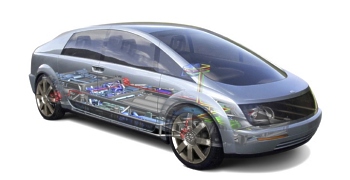
.
. .
..
. . .
Buick Hummer Cars GM Concepts 2003 GM Concepts 2002 GM Concepts 2001
© 1998 - 2004
Copyright & |
.
General Motors: Hy-wire Concept
The GM Hy-wire, appropriately named for its technology, incorporates the features first envisioned in the AUTOnomy concept vehicle at the 2002 North American International Auto Show in Detroit and the Geneva Motor Show.
"All of the touring sedan's propulsion and control systems are contained within an 11-inch-thick skateboard-like chassis, maximizing the interior space for five occupants and their cargo. (see AUTOnomy Concept) There is no engine to see over, no pedals to operate - merely a single unit called X-drive that is easily set to either a left or right driving position." Hy-wire is the product of global cooperation.
"By combining fuel cell and by-wire technology, we've packaged this vehicle in a new way, opening up a new world of chassis architectures and customized bodies for individualized expression," said Chris Borroni-Bird, director of GM's Design and Technology Fusion Group and program director of the Hy-wire concept. "It is a significant step towards a new kind of automobile that is substantially more friendly to the environment and provides consumers positive benefits in driving dynamics, safety and freedom of individual expression."
According to Wayne Cherry, GM's vice president of Design, the
chassis architecture provides designers the freedom to create a number
of different body styles.
Hy-wire is a sporty yet elegant four-door vehicle with clean lines and short overhangs. "It's a luxury vehicle in the sense that it is a luxury to have the kind of space and visibility this car provides," said Ed Welburn, executive director of GM Design for Body-on-Frame Architectures. "The design is built around the fact that there is no engine compartment; the vehicle is very open from front to rear. This is intentional to highlight the openness in the interior and the range of possibilities." To show off this radically new architecture, the front and rear panels are made of transparent glass. Onlookers can see through the car from front to rear; the liberal use of glass and the absence of a hood also provide a greater visual command of the road for the driver. To reinforce this effect even the seat backs are open. There is no post between the front and rear doors, known as a B-pillar. Drivers and passengers have greatly enhanced legroom. "The most dramatic view of this car may be from the driver's seat," Welburn said. "Imagine having no engine, instrument panel or foot pedals in front of you - an open, yet secure cockpit with a floor to ceiling view. It's like being in my living room looking out my picture window." The X-drive, which allows steering, braking and other vehicle systems to be controlled electronically rather than mechanically, provides greater freedom for the driver. Drivers now have the option to brake and accelerate with either the right or left hand. The driver accelerates by gently twisting either the right or left handgrip, and brakes by squeezing the brake actuator also located on the handgrips. The handgrips glide up and down for steering, somewhat different than today's vehicles where the steering wheel revolves around a steering column. The X-drive, which also incorporates an electronic monitor for vital car functions, shuttles easily from side-to-side on a horizontal bar that stretches across the full width of the vehicle. It provides another example of the extreme flexibility of the car's architecture. A single docking port provides the electrical connection between the all-aluminum chassis and the fiberglass body. Mechanically, there are 10 body attachment linkages. The fuel cell stack, which produces a continuously available power of 94 kilowatts, is installed in the back of the chassis. Most of the chassis is 11-inches thick, tapering to 9 inches at the edges. The electrical motor drives the front wheels and is installed transversely between them. Three cylindrical storage tanks (5,000 psi - pounds per square inch or 350 bars) are located centrally in the chassis. "The new packaging of the components was a major challenge and certainly, in terms of compactness, we're not at the finish line yet," said Erhard Schubert, director of the Mainz-Kastel facility. "But this functional prototype impressively demonstrates just how flexible our fuel cell technology is and the opportunities it offers." Hy-wire weighs 1,900 kilograms (4,180 pounds) with 20-inch tires in front and 22-inch tires in the rear. Putting all technical elements into the chassis provides a low center of gravity, giving the architecture both a high safety and driving dynamics potential. Passive safety requirements will be fulfilled using impact-absorbing elements, so-called crash boxes, at a later stage of development. "Most of the powertrain load has been evenly distributed between the front and rear of the chassis so there is a lower center of gravity for the whole vehicle, without sacrificing ground clearance," Borroni-Bird said. "This contributes to the overall safety of the vehicle by enabling superior handling, while resisting rollover forces, with the tallest body attached." Hy-wire so profoundly changes the automotive industry that GM has more than 30 patents in progress covering business models, technologies and manufacturing processes related to the concept and more inventions are being added all the time. "Someday, Hy-wire could be displayed in a museum side-by-side with the first horseless carriages of Carl Benz or Gottlieb Daimler, or next to Henry Ford's Model T," Burns said.
|
|




















 Driving closer to reinventing the automobile, General Motors
Corp. today unveiled Hy-wire, the world's first drivable vehicle
that combines a hydrogen fuel cell with by-wire technology.
Driving closer to reinventing the automobile, General Motors
Corp. today unveiled Hy-wire, the world's first drivable vehicle
that combines a hydrogen fuel cell with by-wire technology.





